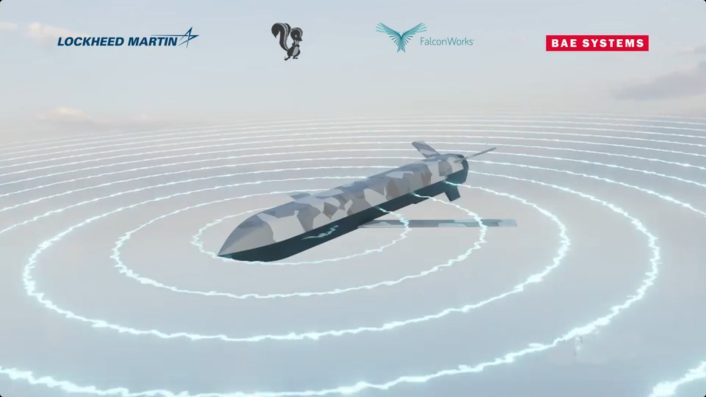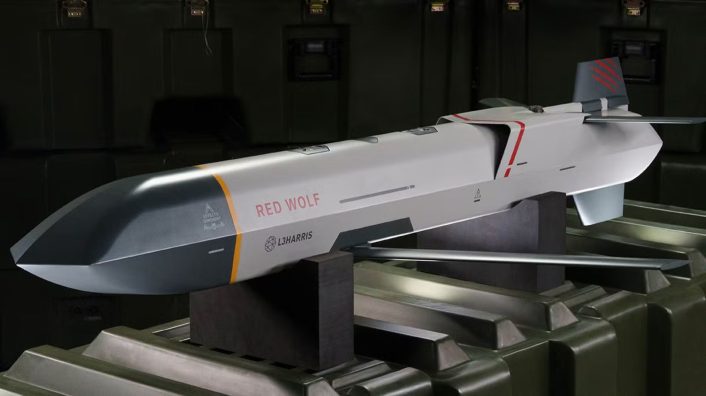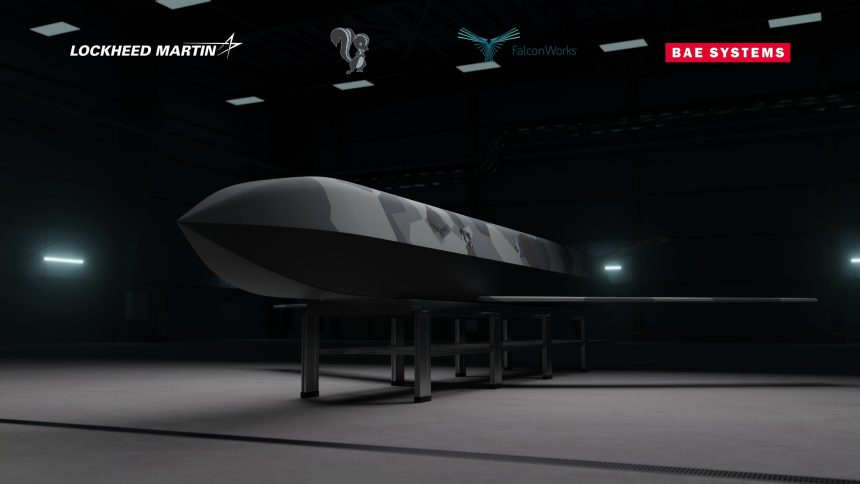The announcement comes as nations are increasingly looking towards a mix of crewed and uncrewed assets to field affordable ‘combat mass’ in support of existing frontline combat platforms.
Lockheed Martin and British defense major BAE Systems announced on Sep. 9, 2025, a partnership to develop a range of uncrewed autonomous air systems. The new systems would find themselves amid a trend of low-cost, autonomous, scalable air-launched munitions and UAVs providing attack, electronic warfare, surveillance, data and communications relay.
The strategic partnership was announced at the DSEI conference in the U.K. and will see Lockheed’s Skunk Works and BAE’s FalconWorks drawing on their “rapid design, prototyping and advanced manufacturing expertise” to develop “a range of uncrewed autonomous air systems [that are] cost-effective and easily deployable with multiple launch options.”
Both companies also released a concept rendition of an air-launched system looking similar to earlier illustrations of Lockheed’s CMMT (Common Multi-Mission Truck). This could however be a very nascent, notional design, with the final product looking significantly different.
Two global innovators.
One powerful partnership.
We’re excited to be working with @LockheedMartin to combine capabilities and develop a range of uncrewed autonomous air systems.
🔗 https://t.co/ImdBFYHfKt pic.twitter.com/PttbJ74tRu
— BAE Systems (@BAESystemsplc) September 9, 2025
As we have noted here at The Aviationist, the lines between cruise missiles and loitering drones are increasingly being blurred. Acting both as UAVs and cruise missiles, the weapons are not aimed to damage, but disrupt and distract, allowing for larger attacks to get through the defenses, while also draining the defenders’ costlier arsenal.
The new system
With a focus on modularity and adaptability, both companies explained that the initial system will be geared towards “delivering an electronic warfare and attack capability that would deliver disruptive capabilities and could complement and enhance the survivability of current crewed combat aircraft.” Additionally, the system will also “offer multiple launch options such as air drop, ground launch, maritime launch and launch from a wide-body aircraft.”
The latter capability clearly points towards palletized launches such as the ones of the AGM-158 JASSM for the Rapid Dragon program, and the CMMT. Rolled off the cargo ramp of aircraft like the C-130J Super Hercules, C-17 Globemaster III and possibly Europe’s A400M fleet, the munitions are meant to saturate the air defenses to clear the way for manned aircraft.

A degree of intelligent autonomy and inter-networking between the drones can be expected to enable them to operate in SATNAV (Satellite Navigation)-denied, heavy jamming environments, which sever guidance and data-link signals. The revelation about the U.S. approving the sale of 3,350 ERAMs (Extended-Range Attack Munitions) to Ukraine late in August, within a year of the AFLCMC (Air Force Life-Cycle Management Center) seeking developers for the systems, bore how such systems can be rapidly developed, prototyped and fielded by the industry.
Lockheed and BAE’s joint press release gave the broader context of today’s weapons development and warfare trends: “The announcement comes at a time when nations are increasingly looking towards developing a mix of crewed and uncrewed assets to address the requirements of today’s rapidly evolving battlespace – and the need to be able to quickly develop and field affordable ‘combat mass’ to support existing frontline combat platforms.”
.@LockheedMartin Skunk Works® and @BAESystemsplc are joining forces to develop a new range of uncrewed autonomous air systems. Click for more:🔗⬇️
— Lockheed Martin News (@LMNews) September 9, 2025
In the press release, Lockheed Martin’s vice president and general manager OJ Sanchez said they were pleased to combine with BAE Systems their “expertise in rapid prototyping and advanced development to deliver game-changing capabilities.” Sanchez further added that “By working together, we’re unlocking new possibilities for our customers and advancing the future of autonomous systems.”
Dave Holmes, managing director of BAE Systems’ FalconWorks division, said: “Through our collaboration with Lockheed Martin we’ll deliver disruptive capabilities that can make a real difference to our military customers at pace, enabling them to confront the operational requirements of today’s battlefield.”
.@LockheedMartin successfully conducts flight tests of two CMMT configurations. Click for more: 🔗⬇️
— Lockheed Martin News (@LMNews) July 16, 2025
Other systems
The Lockheed Martin and BAE Systems product would technically be relatively sophisticated with swappable payloads, yet within the mass-producible category, where the ‘low’ in the ‘low-cost’ would be achieved by pitching the product to other Allies. L3Harris’ Red Wolf and Green Wolf launched effects also fit the same criteria of offering both strike and electronic warfare functions.
Including the future Lockheed and BAE product, there are six such ongoing or completed projects that meet the scalable, diverse effects, and intelligent munitions need. These are Project Artemis, CMMT, ERAM, Red and Green Wolf and Anduril’s Barracuda-100M air vehicle. The last is very similar in class, form and role to the Red/Green Wolf.

Anduril unveiled the Barracuda family last year, which includes the larger and longer-ranged 250 and 500 models, and on Jun. 16, 2025, revealed details of a testing campaign that ended in May. “Anduril’s Barracuda-100M autonomous air vehicle (AAV) achieved a significant milestone in May by completing another series of successful flight tests for the U.S. Army DEVCOM Aviation & Missile Center (AvMC) High-Speed Maneuverable Missile (HSMM) program,” the company said.
The HSMM program aims to create an affordable, high-speed, maneuverable, and modular air vehicle testbed for AvMC’s Precision Target Acquisition Seeker (PTAS) payload. The Government developed PTAS payload is being developed to allow for passive, autonomous tracking of identified targets. It uses video feedback to correlate and seek a previously identified target image using a Long Wave Infrared (LWIR) camera within the seeker.
Successful flight test of Barracuda-100M for the @USArmy‘s High Speed Maneuverable Missile program.
Delivering high-G maneuvers, speeds over 500 knots, and 10x the range of the Hellfire missile. pic.twitter.com/rvAYqodvku
— Anduril Industries (@anduriltech) July 16, 2025
How the Department of War (as the Department of Defense has been recently renamed), the U.S. Air Force and possibly the U.S. Navy will rationalize these diverse industry efforts into a coherent project, and if there will be a single open tender for a particular buy where all the companies compete, remains to be seen.









